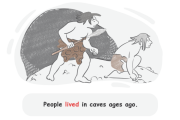Past Simple For beginners
In this lesson, beginners will learn about English Past Simple Tense with easy explanations, clear examples, and practice exercises.

What Is Past Simple Tense?
The past simple tense is used to describe actions that happened and were completed in the past. It's often formed by adding '-ed' to the base form of regular verbs but has different forms for irregular verbs.
Structure
To form the simple past tense, the past tense form of the verb is used.
To form the past form of a regular verb, add '-ed' to the base form of the verb. For example:
walk → walked
play → played
talk → talked
If the verb already ends in '-e', just add '-d' to the base form of the verb. For example:
love → loved
free → freed
bake → baked
Spelling
If a regular verb with one syllable ends with a vowel + a consonant, double the last consonant before adding '-ed' to make it past tense. For example:
beg → begged
skip → skipped


Irregular Verbs
Irregular verbs do not follow the rule mentioned above. These verbs have different forms in the past tense form. For example:
go → went
bring → brought
know → knew
run → ran
have → had
do → did
Past Tense of 'To Be'
'To be' is one of the irregular verbs in English which has two forms for the past tense:
subject | Verb |
|---|---|
You/We/They | Were |
I/He/She/It | Was |
I am a student. → I was a student.
They are kind. → They were kind.
Negation
For negation of past simple verbs, 'did not' or the short form 'didn't' is added before the base form of the verb:
Affirmative | Negative | Short Form |
|---|---|---|
I ran. | I did not run. | I didn't run. |
She walked. | She did not walk. | She didn't walk. |
They talked. | They did not talk. | They didn't talk. |
To negate a 'to be' verb, just add 'not' after its past form (was/were).
Statement | Negation | Short Form |
|---|---|---|
I was happy. | I was not happy. | I wasn't happy. |
They were waiters. | They were not waiters. | They weren't waiters. |
Questions
To form questions using the past simple form, just use 'did' at the beginning of the sentence and change the past form of the verb to its base form:
Statement | Questions |
|---|---|
I ran. | Did I run? |
She walked. | Did she walk? |
To from the simple past question form of a 'to be' verb, just put the verb at the beginning of the sentence and put the subject after it. For example:
Statement | Question |
|---|---|
She was hungry. | Was she hungry? |
They were at the mall. | Were they at the mall? |
Uses
The past simple tense is used to talk about:
Completed actions in the past
I had dinner at around 8 in the evening last night.
Mary graduated from college in 2013.
Pronunciation of '-ed'
'-ed' endings have three different pronunciations:
/d/: After all vowel sounds and voiced consonants (except /d/) ⇒ walked
/t/: After all voiceless consonants (except /t/) ⇒ pressed
/ɪd/: After /d/ and /t/ ⇒ waited
Quiz:
Which of the following sentences is in the past simple tense?
She walks to the store.
She walked to the store.
She walkked to the store.
She walkd to the store.
Which verb is irregular in the past tense?
talk
beg
run
love
Match the past tense formation rule with the correct verbs:
Complete the sentence with the correct past tense form of the verb in parentheses:
She
(play) soccer yesterday.
I
(go) to the market last Saturday.
We
(walk) to the park in the morning.
He
(beg) her to stay.
I
(bake) a cake for the party.
Sort the words to form a correct negative sentence in the past simple tense.
Complete the table by filling in the correct negative form.
| Statement | Negative |
|---|---|
I ran. | I did not . |
She walked. | She did not . |
I was happy. | I happy. |
I called him. | I him. |
Complete the table by filling in the correct question form.
| Statement | Question |
|---|---|
I ran. | you ? |
She walked. | she ? |
I was happy. | you happy? |
I called him. | you him? |
Comments
(0)